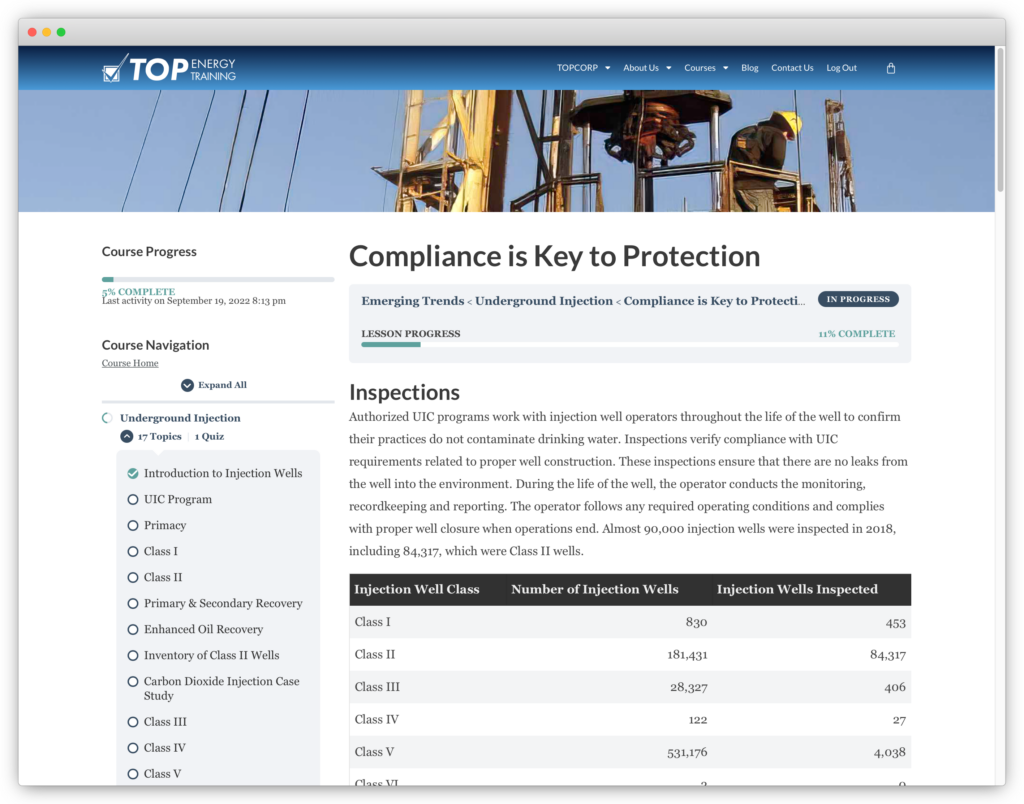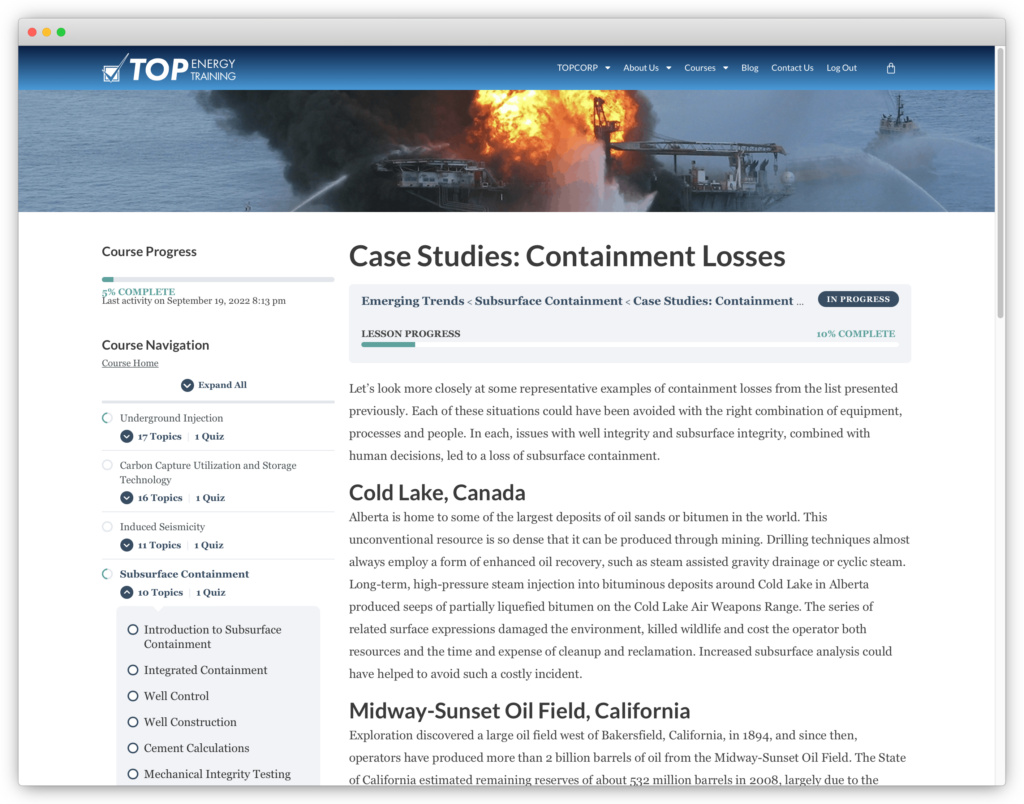Injection Wells and Sustainable Energy Systems: Full Course
4 Lessons • 54 Topics
Do you have business interests in the oil and natural gas industry? Maybe you’re looking to pursue a career in the industry? If so, you could benefit from TOP Energy Training’s online oil and gas training courses. We’ve designed our courses to educate students and industry professionals on the latest technology innovations, and we review our training courses regularly to stay up-to-date with the industry. In our Emerging Injection Wells and Sustainable Energy Systems course, we look at some of the most current topics in the oil and gas sector.
Not sure you want to invest in an entire course? Certain popular lessons are available for individual purchase. Take one of the course lessons to try it out. Your lesson cost can later be applied to the purchase of the full course if you like.
Injection Wells and Sustainable Energy Systems Course Content Overview
Energy production is an ever-changing and evolving field. Covering emerging technical and industrial concerns, this course provides an overview of underground injection, carbon capture utilization and storage, induced seismicity, and subsurface containment.
A case study references induced seismicity at the DFW Airport and the public’s concerns over petroleum operations. We also explore case studies of several high-profile incidents such as the Deepwater Horizon oil spill in the Gulf of Mexico and surface expressions in the San Joaquin Valley area of California.
As our industry moves forward, [TOP Energy’s] training continually evolves as well … by providing online training that covers petroleum geology and engineering concepts, petroleum technology, environmental management technology, and emerging industry topics.
—Lucas Keeler, Inspection Specialist, Wyoming Oil and Gas Conservation Commission


Lessons from the course
Created in conjunction with TOP Energy Training’s highly qualified instructors, each lesson encompasses multiple topics to sharpen your knowledge and technical proficiency.

Underground Injection
17 Topics
Introduced after World War II, the underground injection control has gone through many changes and improvements. This lesson introduces underground injection control (UIC) wells and their primary applications. The curriculum provides a brief overview of regulatory issues, including primacy, describes the different classes of injection wells, and discusses the importance of particular classes to oil and gas operations and geothermal energy. In-depth segments within the lesson highlight injection techniques for enhanced recovery of oil and gas, a geothermal project case study, and case studies of CO₂ injection for enhanced oil recovery as well as geologic storage.

Carbon Capture Utilization and Storage
16 Topics
The lesson on carbon capture utilization and storage (CCUS) presents the role of carbon dioxide injection, both for enhanced oil recovery (EOR) and storage, in the move toward sustainability. A recent establishment of a new class (VI) of injection wells, as well as a number of policy and tax incentives in the U.S., have created renewed interest and activity around CCUS technology. This lesson covers the general history and specifics of Class VI wells, the role of EOR in storage, misconceptions about carbon dioxide, protections for drinking water resources, and Class VI well considerations, such as storage capacity, injection rate, and storage mechanisms.

Induced Seismicity
11 Topics
Induced seismicity refers to earthquakes (in most cases, minor earthquakes) that are the result of human enterprise. Human activities such as geothermal energy access, wastewater injection, well stimulation, carbon storage and other projects all must be well designed and monitored to avoid induced seismicity. This lesson covers foundational topics such as faults and folds, seismic waves, earthquake measurement techniques, a brief history of natural earthquakes, and the geomechanics of fluid injection. A case study explains how these fundamental concepts are applied to understanding, mitigating and preventing induced seismicity in the oil and gas industry.

Subsurface Containment
10 Topics
The primary goal of subsurface containment focuses on preventing leakage of production or injection fluids from their intended zone. In turn, prevention mitigates environmental damage, damage to assets, and negative impacts on drilling and production. Subsurface containment requires a multi-faceted approach incorporating technical, geologic, and human variables. The subsurface containment lesson of this course includes topics such as well control, well construction, aging well infrastructure, subsurface integrity, and several case studies of high-profile, subsurface-containment incidents.
Each lesson has a self-assessment at the end to reinforce the information and prepare you for the next lesson.
Who Should Take This Course?
Professionals working in a variety of energy-related careers (e.g., engineers, geoscientists, attorneys, accountants, managers, regulatory personnel, policymakers) know how important it is to stay current and up-to-date with the latest technology and advancements in the oil and gas sector. Students have a critical need to gain a solid foundation of industry fundamentals and distinguish their future college and/or employment applications. Educators want to present a broad perspective of the technical solutions within the oil and gas industry to their students, highlighting the diverse nature of careers and opportunities within the energy sector.